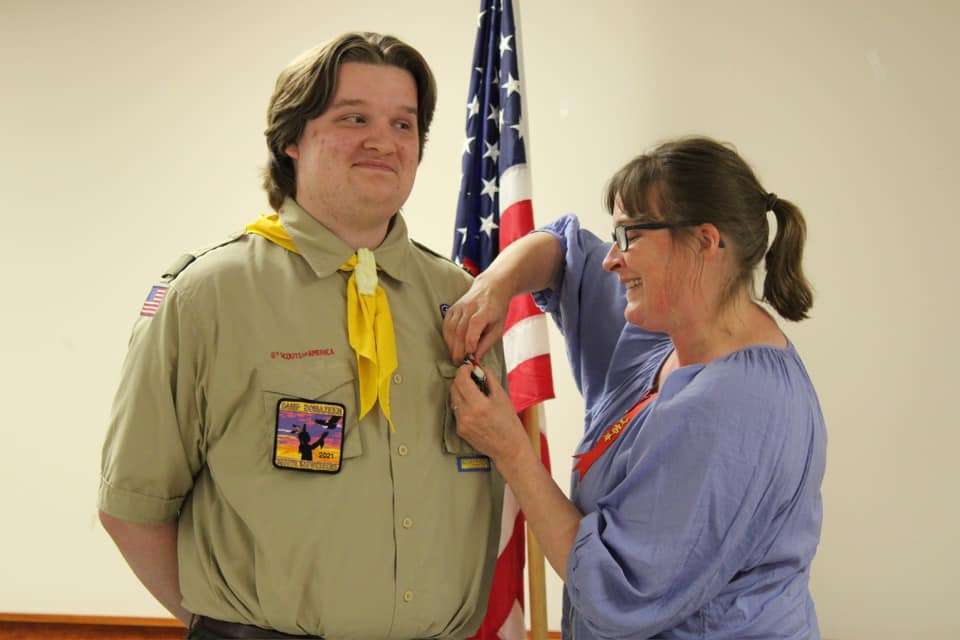
From left to right, Matix Ward, Nash Corson and Preston Roy, of Boy Scout Troop #446, in Albion, were each awarded the Eagle Scout rank in a ceremony held on July 5, 2024. (contributed photo)
The town of Albion is celebrating its bicentennial this year with alumni gatherings, a frying pan throwing contest, parade, fun run and plenty of food. Among the festivities and pageantry, residents and guests are learning more about what makes their community special and of her rich history. A special ceremony honoring three young men who made Eagle Scout, the highest rank in Scouting, took place recently at the Albion Middle School to recognize Troop #446 Eagle Scouts Matix Ward, Preston Roy and Nash Corson. All three are Albion residents.
State Representative Scott Cyrway and Albion Selectmen Jason Dow and Michael Gardner praised the accomplishments of the trio. A slide show highlighting their camping and high adventure experiences captured the attention of all attendees. Lorna Ward was the guest piano accompanist. “I was very impressed,” Alissa Roy said. “It was a very nice ceremony.”
Each of the three Eagle hopefuls had to give leadership to a significant project to benefit the community. In March of this year, Nash organized a blood drive for the American Red Cross and coupled it with a food drive to benefit the Albion Loaves and Fishes Food Pantry. “I wanted to help save lives by collecting blood,” Nash said. “My goal was to have 22 people come out. On the day of my drive, we had 46 donors come and collected 25 units of blood. We had so many people come to donate we had to schedule them for different blood drives as the Red Cross ran out of space to have them all that day. I extended my project to run throughout the month and …ended up having 15 more who donated on other days….I collected approx 60 items for my home town food pantry.”
In January, Matix led volunteers in building a picnic table and hiking trail for Thurston Park, in China. Preston, who completed his project in 2022, led a team to construct new side stairs for the Albion Public Library and revamped the wheelchair ramp as well.
Nash Corson is the son of Alyssa and Michael Corson, of Albion. Nash is 18 and in September will be going into his senior year at Lawrence High School, in Fairfield, and also his last year at Kennebec Valley Community College where he is working towards earning his welding certificate. His mother Alyssa said, “Having watched Nash grow and mature throughout his Scouting career, I can say that Scouting has benefited him immensely and he would not be the driven young man he is without the family and backbone that Scouting has given him.”
Preston, 17, is the son of Alissa and Chuck Roy, of Albion. In 2022, Preston shot a 232-pound, 10-point buck during Youth Deer Hunting Day introducing him to the “Biggest Bucks in Maine Club.” Preston is going into his senior year at Lawrence High School.
Matix is 19 and the son of Elizabeth and Matthew Ward, of Albion. He is going to be a sophomore at the University of New Hampshire where he is majoring in mechanical engineering. He is a graduate of Lawrence High School.
“Matix gained leadership skills, a love for nature, lifelong friends, and a commitment to his community through Scouting,” Elizabeth Ward said. “Through volunteer work, Matix has shown a strong commitment to serving his hometown.”
The ceremony was held on July 5, 2024. While 2024 marks the two hundredth anniversary of Albion, these three Eagles have helped shape her next two centuries.









 All incoming freshmen or new students and their parents are invited to attend the Erskine Academy New Student Orientation, on Tuesday, August 27, at 6:30 p.m., in the gym. The administration strongly encourages all incoming students to attend this event as it is an opportunity to become further acquainted with the faculty, facilities, and programs at Erskine. The first day of school for freshmen only will be Wednesday, August 28.
All incoming freshmen or new students and their parents are invited to attend the Erskine Academy New Student Orientation, on Tuesday, August 27, at 6:30 p.m., in the gym. The administration strongly encourages all incoming students to attend this event as it is an opportunity to become further acquainted with the faculty, facilities, and programs at Erskine. The first day of school for freshmen only will be Wednesday, August 28.


